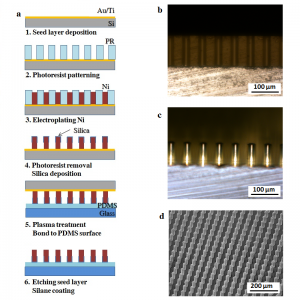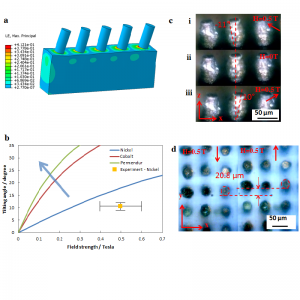Design and Fabrication of Magnetically Tunable Microstructured Surfaces
- Category: Materials, MEMS & BioMEMS
- Tags: evelyn wang, yangying zhu
Micro- and nanostructured surfaces have broad applications ranging from liquid transport in microfluidics and cell manipulation in biological systems to light tuning in optical applications[1][2]. While significant efforts have focused on fabricating static micro/nanostructured arrays[3], uniform arrays that can be dynamically tuned have not yet been demonstrated. We present a novel fabrication process for magnetically tunable microstructured surfaces, where the tilting angle can be controlled upon application of an external magnetic field. We also demonstrate this platform for droplet and bubble manipulation in heat transfer applications.
The tunable surfaces consist of ferromagnetic (Ni) pillars on a soft PDMS substrate. The pillars have a diameter of 23-35 µm, pitch of 60-70 µm, and height of 70-80 µm. We used vibrating sample magnetometry to obtain hysteresis loops of the Ni pillar arrays, which match well the properties of bulk Ni. With a field strength of 0.5±0.1 Tesla and a field angle of 60±15°, a uniform 10.5±0.5° tilting angle of the pillar arrays was observed. Meanwhile, simulations using Abaqus to determine the equilibrium positions of the pillars under different applied fields show good agreement with the experiments. We also investigated how these tunable pillars changed the contact angle of water droplets on the surface. An external magnetic field of 0.3 Tesla changed the water droplet contact angle by ~15°. Future work will focus on using these surfaces to actively transport water droplets and spread the liquid film via pillar movement. These tunable surfaces promise new fluid manipulation capability for applications in condensation, evaporation, and boiling.
- Figure 1: Fabrication process and images of fabricated tunable micropillars with diameters of 24 27 µm, heights of 60 80 µm, and spacings of 60 µm. a) Fabrication process flow. b) Optical microscope image of a sample after step 2. c) Optical microscope image of a sample after step 4. d) SEM of a sample after step 6.
- Figure 2: Simulation and experimental demonstration of tilting pillars. a) Finite element (Abaqus) simulation of tilt angle when h=80μm d=26μm, field is 0.7 Tesla at 60°. Legend represents the strain. b) Simulation result of tilt angle as a function of field. Square symbol shows experimentally demonstrated result. c) Time-lapse side view image of a sample with field of ~0.5 Tesla at ~60°. d) Time-lapse top view image of a sample with field of~0.5 Tesla at ~60°.
- R. Xiao and E. N. Wang, “Microscale Liquid Dynamics and the Effect on Macroscale Propagation in Pillar Arrays,” Langmuir, vol. 27, pp. 10360-10364, 2011. [↩]
- J. Fu, Y. Wang, M. T. Yang, R. A. Desai, X. Yu, Z. Liu and C. S. Chen, “Mechanical regulation of cell function with geometrically modulated elastomeric substrates,” Nature Methods, vol. 7, pp. 733-736, 2010. [↩]
- K. Chu, R. Xiao and E. N. Wang, “Uni-directional Liquid Spreading on Asymmetric Nanostructured Surfaces,” Nature Materials, vol. 9, pp. 413-417, 2010. [↩]

